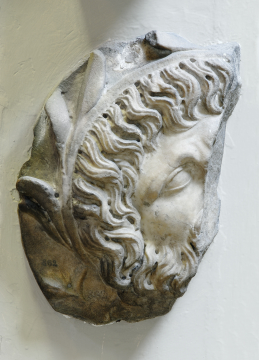Explore Collections


You are here:
CollectionsOnline
/
A fragment from the lid of a sarcophagus or from a large basin(?)
Browse
A fragment from the lid of a sarcophagus or from a large basin(?)
Pentelic marble
Height (as mounted): 29cm
Width: 21cm
Depth: 8cm
Width: 21cm
Depth: 8cm
Museum number: M862
On display: Dome Area
All spaces are in No. 13 Lincoln's Inn Fields unless identified as in No. 12, Soane's first house.
For tours https://www.soane.org/your-visit
Curatorial note
This piece depicts a fragmentary bearded, moustached head, perhaps that of freshwater God, encircled with a stylised wreath of freshwater reeds between two thin fillet bands. The break runs so as to leave part of the hair and brow beyond the centre line through the nose, indicating that what remained or was shown of the face beyond this vertical line was carved on the same plane and did not run back as in a wedge-shaped corner acroterion.
This fragment is possibly from the front centre or the front right corner of a sarcophagus lid. If so, it is of a an uncommon shape. The piece may have had a rectangular top and slight left back edge - as in the two corner masks joined together in the Conservatori Gardens1, especially that to the right: "set within a panel which is broken above and below" [this quote probably from Jones, see note 1 below]. An example in the Ny Carlsberg Glyptothek, Copenhagen2, is a similar bearded male head, with curved left side and top, from a sarcophagus lid. Another in the Museo dei Scavi, Fiesole, consists of part of the front panel of the lid and a flat face of a young freshwater god set on an angle surface to the front and right end - like a corner ante-fix rather that the usual acroterion.
A more probable parallel origin for this fragment lies, like so many examples in the Soane collection, in the fragments of colossal marble vases excavated from such sites as Hadrian's Villa at Tivoli. The two large alabaster or variegated marble bowls at the foot of the Louvre classical galleries staircase have Medusa and water-god masks in their bottom centres.3 The river-god mask, with reeds in his hair, suggests the decorative function paralled by the Soane fragment. Like the centre of Louvre bowl, this Soane relief was probably a separately carved, raised medallion and may therefore be connected with such Roman Villa and bath sculpture in the Hellenistic tradition. In the second connection there are two such masks from frieze or panelling enrichment of the Baths of Caracalla, preserved near the modern entrance to that ruin in Rome.
1 The British School at Rome, Catalogue of ancient sculptures preserved in the municipal collections of Rome: The Sculptures of the Palazzo dei Conservatori, H.S. Jones, Oxford, 1926, p. 246, no. 86, pl. 95.
2 Antike Kunstvaerker I Ny Carlsberg Glyptotek; Billedtavler (1907), 1. Tilloeg (1915), 2. Tilloeg (1941), pl. LXVIII, no. 793.
3 S. Reinach, Répertoire de la Statuaire Grecque et Romaine, I, Clarac de Poche, Paris, 1897, p. 126, nos. 4-6.
This fragment is possibly from the front centre or the front right corner of a sarcophagus lid. If so, it is of a an uncommon shape. The piece may have had a rectangular top and slight left back edge - as in the two corner masks joined together in the Conservatori Gardens1, especially that to the right: "set within a panel which is broken above and below" [this quote probably from Jones, see note 1 below]. An example in the Ny Carlsberg Glyptothek, Copenhagen2, is a similar bearded male head, with curved left side and top, from a sarcophagus lid. Another in the Museo dei Scavi, Fiesole, consists of part of the front panel of the lid and a flat face of a young freshwater god set on an angle surface to the front and right end - like a corner ante-fix rather that the usual acroterion.
A more probable parallel origin for this fragment lies, like so many examples in the Soane collection, in the fragments of colossal marble vases excavated from such sites as Hadrian's Villa at Tivoli. The two large alabaster or variegated marble bowls at the foot of the Louvre classical galleries staircase have Medusa and water-god masks in their bottom centres.3 The river-god mask, with reeds in his hair, suggests the decorative function paralled by the Soane fragment. Like the centre of Louvre bowl, this Soane relief was probably a separately carved, raised medallion and may therefore be connected with such Roman Villa and bath sculpture in the Hellenistic tradition. In the second connection there are two such masks from frieze or panelling enrichment of the Baths of Caracalla, preserved near the modern entrance to that ruin in Rome.
1 The British School at Rome, Catalogue of ancient sculptures preserved in the municipal collections of Rome: The Sculptures of the Palazzo dei Conservatori, H.S. Jones, Oxford, 1926, p. 246, no. 86, pl. 95.
2 Antike Kunstvaerker I Ny Carlsberg Glyptotek; Billedtavler (1907), 1. Tilloeg (1915), 2. Tilloeg (1941), pl. LXVIII, no. 793.
3 S. Reinach, Répertoire de la Statuaire Grecque et Romaine, I, Clarac de Poche, Paris, 1897, p. 126, nos. 4-6.
In Soane's collection by 1811 when it is shown a watercolour view of the Museum by J.M. Gandy, SM P384.
Soane collections online is being continually updated. If you wish to find out more or if you have any further information about this object please contact us: worksofart@soane.org.uk


